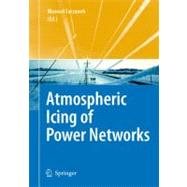
| Modern Meteorology and Atmospheric Icing | p. 1 |
| Introduction | p. 1 |
| Atmospheric Icing - A Brief Survey of Icing Processes and their Meteorological Aspects | p. 4 |
| Icing Models | p. 7 |
| Introduction to Numerical Weather Prediction Models | p. 9 |
| Some Preliminary Applications of Fine-Scale Models | p. 11 |
| Condensation Schemes in NWP Models - Relevance for Icing Prediction | p. 17 |
| A Case Study: Using Numerical Weather Prediction Models to Forecast In-cloud Atmospheric Icing Episodes | p. 21 |
| Concluding Comments | p. 26 |
| References | p. 27 |
| Statistical Analysis of Icing Event Data for Transmission Line Design Purposes | p. 31 |
| Introduction | p. 31 |
| Measurements and Database | p. 32 |
| Statistical Analysis and Modelling Ice Loads on Overhead Transmission Lines | p. 40 |
| Conclusions | p. 78 |
| References | p. 80 |
| Numerical Modelling of Icing on Power Network Equipment | p. 83 |
| Introduction | p. 83 |
| The Fundamental Equation of Icing | p. 85 |
| Computing the Rate of Icing | p. 89 |
| Numerical Modelling | p. 100 |
| Conclusions | p. 106 |
| References | p. 110 |
| Wet Snow Accretion on Overhead Lines | p. 119 |
| Introduction | p. 119 |
| Microphysics of Wet Snow | p. 119 |
| Thermodynamic Analysis of Heat Exchanges | p. 121 |
| Modelling the Cylindrical Growth of Wet Snow Sleeves | p. 129 |
| Simulation of Accretion Mechanisms in Wind Tunnel Conditions | p. 131 |
| Observation of Accretion Mechanisms in Natural Climatic Conditions | p. 140 |
| Applications to Forecasting, Preventing, and Mapping the Wet Snow Overload Hazard | p. 154 |
| References | p. 166 |
| Effect of Ice and Snow on the Dynamics of Transmission Line Conductors | p. 171 |
| Introduction | p. 171 |
| Aeolian Vibrations | p. 172 |
| Wake-induced Oscillations | p. 179 |
| Galloping Conductors | p. 182 |
| Protection Methods for Galloping | p. 209 |
| Galloping Amplitudes | p. 214 |
| Ice Shedding | p. 219 |
| Bundle Rolling | p. 222 |
| Conclusion | p. 224 |
| References | p. 225 |
| Anti-icing and De-icing Techniques for Overhead Lines | p. 229 |
| Introduction | p. 229 |
| Anti-icing Techniques | p. 230 |
| De-icing Techniques | p. 236 |
| Joule-Effect Methods | p. 245 |
| Methods for Limiting Ice Accretion Weight | p. 252 |
| Practical Aspects | p. 255 |
| New Developments in Anti-icing Methods | p. 258 |
| Conclusions | p. 264 |
| References | p. 265 |
| Effects of Ice and Snow on the Electrical Performance of Power Network Insulators | p. 269 |
| Introduction | p. 269 |
| Insulator Functions, Dimensions and Materials | p. 270 |
| Ice and Snow Accretion on Insulators | p. 271 |
| Ice Flashover Processes and Mechanisms | p. 278 |
| Cold-Fog Flashover Process and Mechanisms | p. 283 |
| Snow Flashover Process and Mechanisms | p. 286 |
| Mathematical Modelling of Flashovers on Insulators Covered with Ice or Snow | p. 291 |
| Recommended Test Methods | p. 301 |
| Insulation Coordination for Ice and Snow Conditions | p. 306 |
| Mitigation Options to Improve Network Reliability in Winter Flashover Conditions | p. 314 |
| Conclusions and Recommendations | p. 322 |
| References | p. 323 |
| Design of Transmission Lines for Atmospheric Icing | p. 327 |
| Introduction | p. 327 |
| Types of Atmospheric Icing Accretion | p. 328 |
| Ice Accretion on Overhead Line Conductors and Structures | p. 329 |
| Ice Load Measurements | p. 333 |
| Standards for Ice Loads | p. 335 |
| Transmission Line System | p. 338 |
| Design Methodology | p. 343 |
| Deterministic Design Approach | p. 344 |
| Reliability-based Design (RBD) Approach | p. 346 |
| Return Period | p. 349 |
| Variability of Component Resistance | p. 349 |
| Other Loads | p. 351 |
| Ice/Snow Accretion Mitigation Techniques | p. 356 |
| Lessons from the 1998 Ice Storm | p. 356 |
| Concluding Remarks | p. 357 |
| Appendix | p. 358 |
| References | p. 369 |
| Index | p. 373 |
| Table of Contents provided by Ingram. All Rights Reserved. |
The New copy of this book will include any supplemental materials advertised. Please check the title of the book to determine if it should include any access cards, study guides, lab manuals, CDs, etc.
The Used, Rental and eBook copies of this book are not guaranteed to include any supplemental materials. Typically, only the book itself is included. This is true even if the title states it includes any access cards, study guides, lab manuals, CDs, etc.